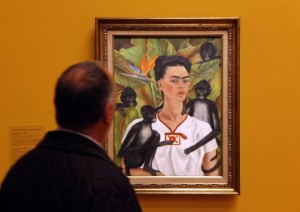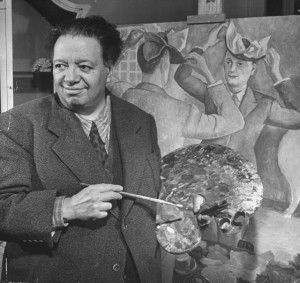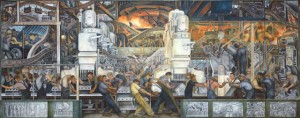Hispanic Heritage Month: Frida Kahlo and Diego Rivera
Friday, September 15th, 2023
Frida Kahlo’s painting Self Portrait with Monkeys hangs at an exhibition.
© Dieter Nagl, AFPGetty Images
People in the United States observe National Hispanic Heritage Month each year from September 15 to October 15. During this period, many Latin American countries celebrate their independence. These countries include Cuba, Costa Rica, El Salvador, Guatemala, Honduras, Mexico, and Nicaragua.
Frida Kahlo remains an influential painter and feminist icon. Kahlo was an important Mexican painter known for her harsh, revealing self-portraits. Despite living in the 1900′s, she refused to conform to strict gender stereotypes. She boxed, challenged men, dressed in masculine clothing, and smoked. Kahlo was also known for her fashion, wearing traditional-style, colorful dresses, and adorning her hair with flowers and braided styles. Always known for living honestly, Kahlo was openly bisexual.
At the age of 18, she was severely injured in an accident while riding on a bus in Mexico City. Kahlo lived in constant pain and was crippled for the rest of her life. She underwent about 35 operations, including the amputation of one leg. Unable to pursue her dream of becoming a doctor, Kahlo taught herself to paint. In 1929, she married the famous Mexican artist Diego Rivera. Their stormy relationship involved separations, divorce, and remarriage.

Frida Kahlo was an important Mexican painter known for her self-portraits that reflected her physical and emotional suffering. Many of her other paintings include symbolic images and elements from Mexican history.
© Hulton Archive/Getty Images
Kahlo’s paintings are mostly self-portraits that reflect her physical and emotional suffering. She painted with jarring colors and odd spatial relationships. Many of her pictures include startling symbolic images and elements from Mexican history. She often portrayed herself wearing colorful Mexican Indigenous dress and ornaments. Kahlo was born on July 6, 1907, in Coyoacán, in southwest Mexico City. She died on July 13, 1954.

Diego Rivera was a Mexican artist who was famous for painting murals that portrayed Mexican life and history. Rivera is shown here standing in front of one of his paintings.
© Ed Clark, Time Life Pictures/Getty Images
Diego Rivera became famous for murals that portrayed Mexican life and history. Rivera was a controversial figure because of his radical political beliefs and his attacks on the church and clergy.
Rivera was born on Dec. 8, 1886, in Guanajuato. In the 1920′s, he became involved in the new Mexican mural movement. With such Mexican artists as Jose Clemente Orozco and David Siqueiros, he began to experiment with fresco painting on large walls. Rivera soon developed his own style of large, simplified figures and bold colors. Many of his murals deal symbolically with Mexican society and thought after the country’s 1910 revolution. Some of Rivera’s best murals are in the National Palace in Mexico City and at the National Agricultural School in Chapingo, near Mexico City.

Diego Rivera was a Mexican artist famous for his murals. His Detroit Industry Murals are a series of frescoes consisting of 27 panels portraying industry in Detroit. Together they surround the Rivera Court in the Detroit Institute of Arts. A main panel on the north wall shows laborers working at the Ford Motor Company’s River Rouge plant. The artist painted the murals in 1932 and 1933.
Detail of a mural depicting Detroit Industry (1932-33), fresco by Diego Rivera; Detroit Institute of Arts/Gift of Edsel B. Ford (Bridgeman Images)
Rivera painted several significant works in the United States, which he visited in the early 1930′s and again in 1940. Perhaps his finest surviving United States work is a mural at the Detroit Institute of Arts. Rivera died on Nov. 25, 1957.


